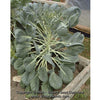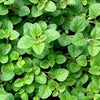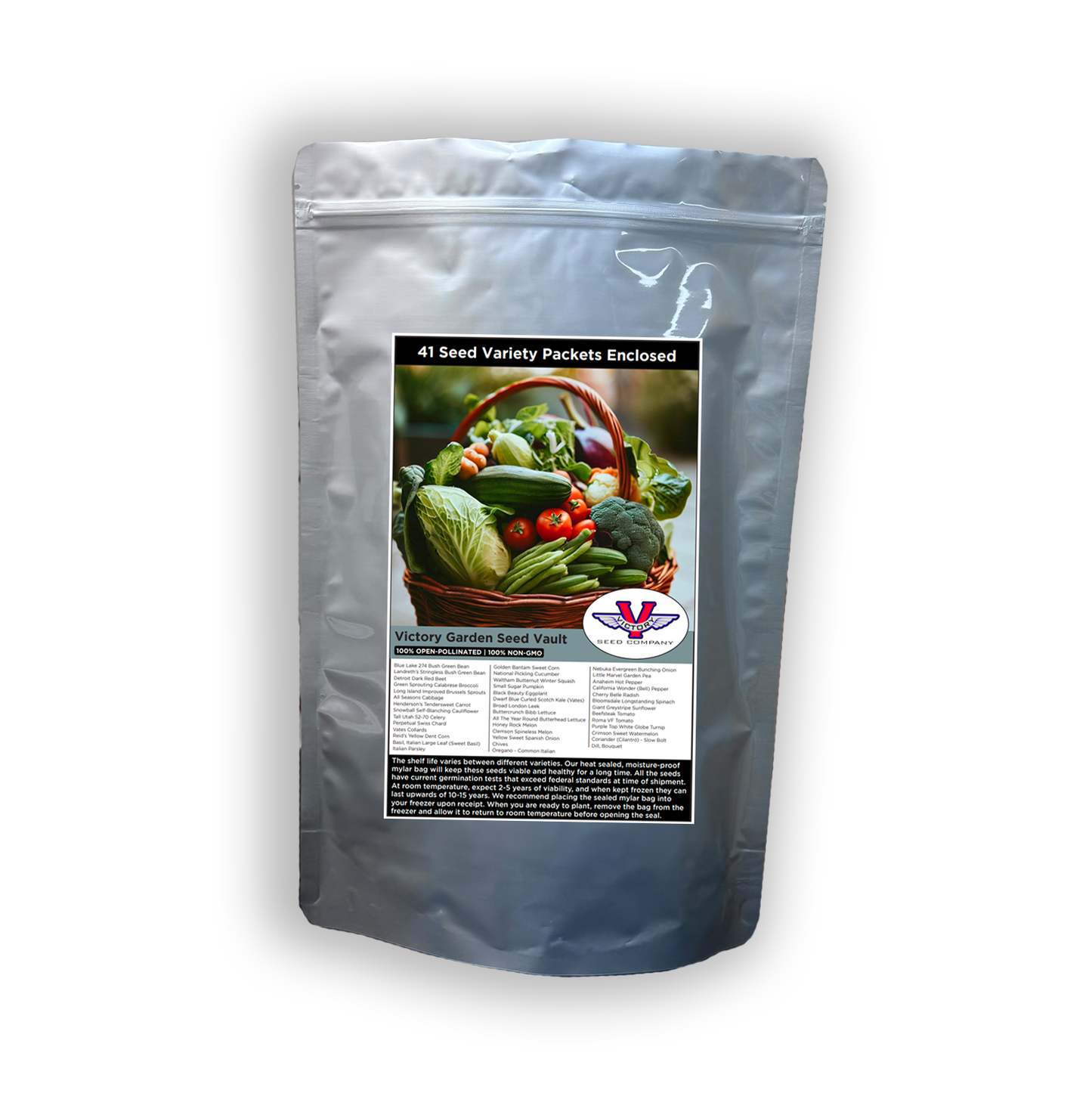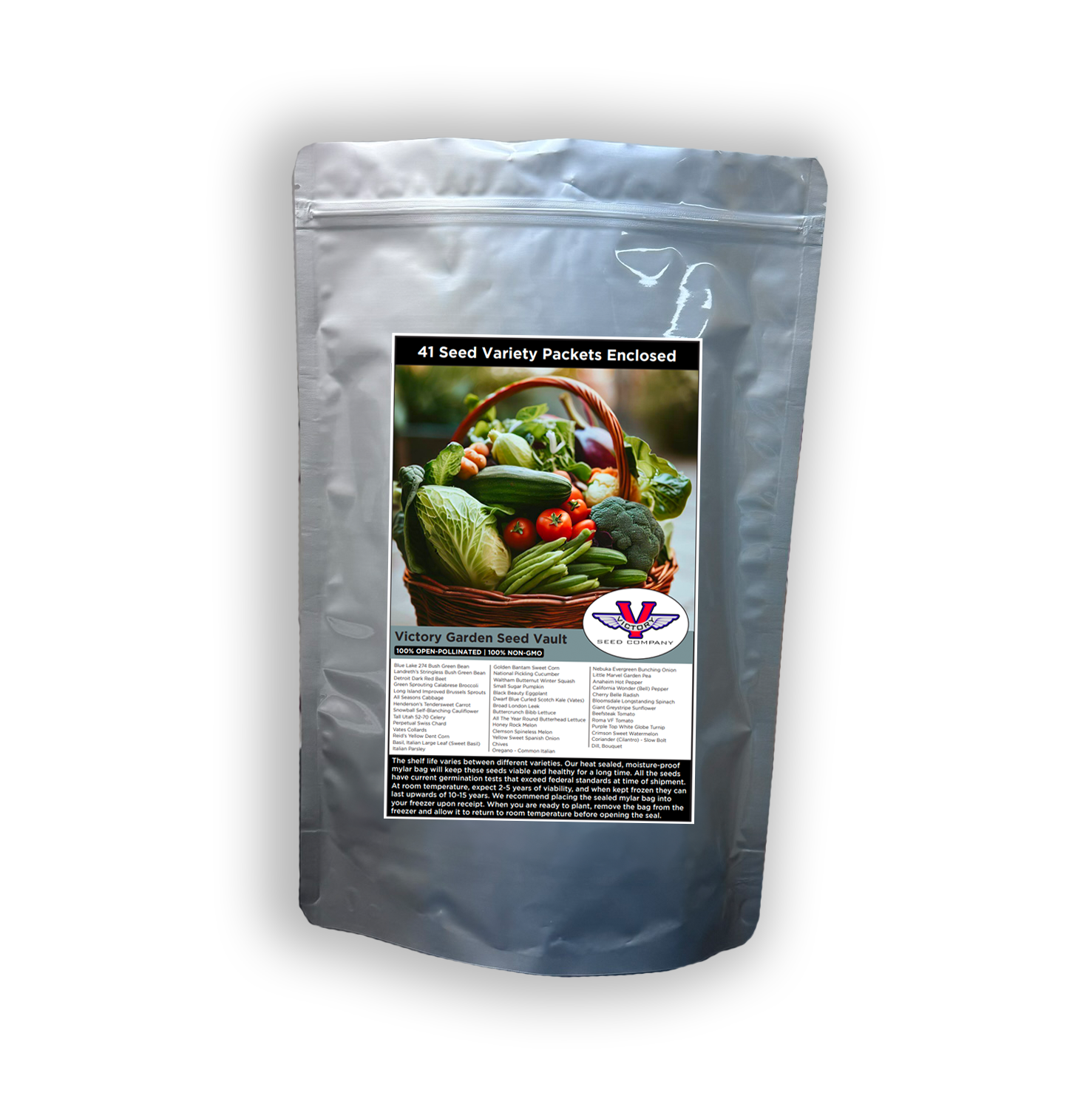Victory Garden Seed Vault
Victory Garden Seed Vault
Couldn't load pickup availability
Specification and Ordering Page
100% Non-GMO
100% Open-Pollinated
There is no such thing as a "one size fits all" garden seed collection. Any kit or collection will not consider personal taste preferences, your specific garden conditions, or your skill level. Our Victory Garden Seed Vault is simply a response to the many requests we have received over the years for a quick and easy way of ordering a broad selection of seeds.
Place a single order for this item and you will get one packet of each of the items shown below at an overall discount. If you prefer, you can order them individually one by one, by clicking on each item in the list.
 Basil, Italian Large Leaf (Sweet)
Basil, Italian Large Leaf (Sweet)A native to Europe and cultivated for centuries as a fresh and dried culinary herb. Common in America by the late 1700s. The plants grow to about eighteen inches, and provide several harvests. The leaves are used fresh to make pesto, and can be dried and used as a seasoning. A favorite in Italian dishes. Prefers well-drained soil, even moisture, and full sun.
 Blue Lake 274 Bush Green Bean
Blue Lake 274 Bush Green BeanPick the pods while young as they are more tender and succulent and less likely to be stringy. This variety is a canner's favorite as it tends to mature its heavy crop all at once.
 Landreth's Stringless Bush Green Bean
Landreth's Stringless Bush Green BeanPick the pods while young as they are more tender and succulent and less likely to be stringy. Released in 1885 by the Landreth Seed Co. The pods are green, round in cross-section, about 5 inches long, slightly curved, meaty, tasty, tender and nearly fibreless borne on 20 inch, erect plants that don’t require support.
 Detroit Dark Red Beet
Detroit Dark Red BeetVery tasty fresh out of the garden, it also maintains its taste and texture well after being canned or pickled. Globe shaped, excellent color, sweet, smooth and tender.
 Green Sprouting Calabrese Broccoli
Green Sprouting Calabrese BroccoliHarvest the heads before the individual flowers mature and begin to open.
 Long Island Improved Brussels Sprouts
Long Island Improved Brussels SproutsThe sprouts are closely set, tight, firm, dark green, on a 20 to 24 inch tall plant. Although they are excellent fresh, they freeze well. This standard old variety dates back to the 1890s.
 All Seasons Cabbage
All Seasons CabbageAlso known as 'Vandergaw', this variety is heat resistant, fine-flavored and produces good, hard heads that are ten inches in diameter, average about 12 pounds and are round but flattened on top. Released in 1886.
 Henderson's Tendersweet Carrot
Henderson's Tendersweet Carrot'Henderson's Tendersweet' carrot plants have a distinct, dark green foliage. When the roots reach full maturity, they are a deep orange color, average from eight to ten inches in length, and taper slightly from the shoulder to a blunt end.
 Snowball Self-Blanching Cauliflower
Snowball Self-Blanching CauliflowerA snowball-type with leaves that curl in the cool fall weather and cover the head to keep the white color. They do not require tying until the heads are six to eight inches across.
 Tall Utah 52-70 Celery
Tall Utah 52-70 CeleryThis variety produces eleven to twelve inch stalks on plants that reach about thirty inches in height and are medium dark green, crisp, tender and tasty. Released in 1953.
 Perpetual Swiss Chard
Perpetual Swiss ChardLeaves are smooth, dark-green in color with fine midribs. It is very vigorous and provides an almost "perpetual" harvest. If you garden in an area with a hot climate, it is a great choice for a continuous supply of tasty summertime greens.
 Vates Collards
Vates CollardsLarge, upright, twenty-four inches tall, dark green leaves with a mild, cabbage-like flavor. Used for boiling. It is bolt and frost resistant and the veins do not purple.
 Reid's Yellow Dent Corn
Reid's Yellow Dent CornAt one time this was the most popular variety in the corn belt. It is a medium maturing variety, has big ears of large yellow kernels with good shuck coverage. Mainly used for flour, meal, and feed.
 Golden Bantam Sweet Corn
Golden Bantam Sweet CornThe plants grow to about six feet and produce seven inch ears loaded with eight rows of sweet, plump, golden kernels. Bred by a farmer named William Chambers of Greenfield, Mass. Introduced by W. Atlee Burpee in 1902. Prior to this introduction, people thought that yellow corn was fit only for animal feed.
 National Pickling Cucumber
National Pickling CucumberA heavy producer of straight, medium green colored, black-spined fruit, that average 1-3/4 by 6-inches in size. Can be harvested at two inches long or at full maturity at five inches.
 Waltham Butternut Winter Squash
Waltham Butternut Winter SquashLight tan, seven to nine inches long with a thick neck and a small seed cavity. The flesh is a wonderful, bright orange. An "All-American Selection®" in 1970.
 Small Sugar Pumpkin
Small Sugar PumpkinShould keep well into winter if stored in a moderately cool, dry place. Six to eight inch diameter fruits, weighing six pounds, with small seed cavities and lots of smooth-textured meat.
 Black Beauty Eggplant
Black Beauty EggplantBroad, dark purple egg-shaped fruits that range between four to six inches are borne well off of the ground on medium-sized plants.
 Chives
ChivesPlanting Depth – ¼ inch Seed Spacing – 4 to 5 in. Plant Height – 10 inches Spacing after Thinning – 6 inches Sow seeds in a sunny location after all danger of frost has passed. Can also be started in pots and transplanted. Optimal germination soil temperature is 60ºF to 70ºF. They prefer rich, well-drained soil. If the scrapes (stalks) start looking old, simply cut them back. During the growing season, the plants will continually regrow. In colder climates, the plants will die back to the bulbs and can benefit from being covered with a layer of mulch or straw. Use fresh by harvesting or dry and enjoy as a garnish. Plant in pots in a sunny windowsill to enjoy year round.
 Coriander (Cilantro) - Slow Bolt
Coriander (Cilantro) - Slow BoltPlanting Depth – ½ inch Plant Spacing – 5 to 8 inches Plant Height – 1 to 3 feet Coriander is very easy to grow. Sow seeds directly into the garden after danger of frost has past. It does not transplant well. The leaves are also used fresh in soups, salads and salsas. When used in this form as a fresh, green seasoning, it is called "Cilantro." After the plant has matured, the seeds are harvested to be used as the seasoning "Coriander." Coriander is used as a flavoring for meats, sausages, pickles and sauces.
 Bouquet Dill
Bouquet DillPlanting Depth - ¼ inch Seed Spacing - 1 inch Row Spacing - 24 inches Spacing after Thinning - 8 inches Sow in average soil after all danger of frost has passed. Harvest while the flowering heads are still green. Pull plant, roots and all. Use fresh or hang upside down in a dark and dry location until completely dry. Seeds and leaves are also used dried as a culinary herb. Fine, tender parts are finely chopped and added to sauces. Also used fresh in pickling.
 Oregano - Common Italian
Oregano - Common ItalianOregano is a standard kitchen herb used for Italian and Mexican dishes. Its dried leaves add a warm, spicy flavor to recipes. The plant is a perennial, has pink flowers, and spreads via under-ground runners. In early spring, sow seeds indoors, 1/8 inch deep in sterile soil. Be sure that you keep the temperature above 70ºF and provide 14 to 16 hours of light. After danger of frost has passed, and after the plants are hardened off and about three inches tall, plant outdoors in well-drained soil. Oregano prefers to be kept slightly dry and in full sun. Harvest in summer or early fall before the plants are in full bloom by cutting the stems, flower heads and all, and drying in a cool place with good air movement.
 Dwarf Blue Curled Scotch Kale (Vates)
Dwarf Blue Curled Scotch Kale (Vates)The leaves are finely curled, bluish green, low growing at twelve to fifteen inches tall with a spread of twenty four to thirty inches. It stands well and is hardy.
 Broad London (Large American Flag) Leek
Broad London (Large American Flag) LeekThick sturdy stalks with pearly-white bulbs. Popular main season variety.
 Buttercrunch Bibb Lettuce
Buttercrunch Bibb LettuceLong lasting, heat tolerant, dark green with reddish tints. The heads are rosette shaped with thick leaves. Introduced in 1963 and an "All-American Selection®" winner the same year.
 All The Year Round Butterhead Lettuce
All The Year Round Butterhead LettuceMedium-sized heads stay firm and solid even in hot weather. Can be sown in most locations from about March through August for a nearly "year-round" harvest periods. It does well in both hot and cooler locations.
 Honey Rock Melon
Honey Rock MelonThe fruits are up to 6 inches in diameter with a tough, coarsely netted skin and sweet, flavorful salmon colored flesh. The plants are vigorous, produce 5 to 7 fruits per plant and are disease resistant. Introduced in about 1920.
 Clemson Spineless 80 Okra
Clemson Spineless 80 OkraAn "All-America Selection®" winner in 1939. Plants are 3 to 5 feet with deep-green, straight, spineless, ribbed, 6 to 9 inch pods.
 Yellow Sweet Spanish Onion
Yellow Sweet Spanish OnionExtra large (up to six inch) globe shaped onion. The skin is a straw color and the flesh is white. It has a popular mild and sweet flavor. 'Yellow Sweet Spanish' is an indeterminate variety that reportedly does well in long day regions and stores well.
 Nebuka Evergreen Bunching Onion
Nebuka Evergreen Bunching OnionThis Japanese bunching variety grows twelve to sixteen inches tall, multiply by division, and do not form bulbs under most conditions. They are cold hardy and reportedly resistant to Pink Root, smut, and thrips.
 Italian Parsley
Italian ParsleyPlants have deeply cut, dark green leaves with a rich, strong flavor; generally stronger in flavor than the curled types. Excellent for flavoring. Parsley has been cultivated for centuries and is used as a garnish, palate cleanser, flavoring in soups, salads, as a seasoning in other recipes, and medicinally.
 Little Marvel Garden Pea
Little Marvel Garden PeaIt was released by Sutton & Sons of Reading, England in 1900 and was first sold in the United States by James J. H. Gregory in 1908.
 Anaheim Hot Pepper
Anaheim Hot PepperThe pods develop from 6 to 8½ inches long by 1½ inches long, tapered, medium thick, pungent, that are deep green, turning to red at maturity. Can be used fresh, canned or dried. The plants are tall, upright, bushy, and long bearing.
 California Wonder (Bell) Pepper
California Wonder (Bell) PepperThe plants are upright, strong, and produce four or five fruits that are mostly four-lobed, blocky, and 4 by 4½ inches with thick flesh that is mild and sweet.
 Cherry Belle Radish
Cherry Belle RadishA quick growing, globe shaped radish with bright red skin and crisp, firm, white flesh. 'Cherry Belle' was an "All-American Selection®" winner in 1949.
 Bloomsdale Longstanding Spinach
Bloomsdale Longstanding SpinachLeaves are dark green and crumpled. Stands well in hot weather. Named after their farm in Bristol, PA, D. Landreth & Co. released ‘Bloomsdale’ in the 19th century. 'Long Standing Bloomsdale' was developed and introduced in 1925 by Zwaan and Van der Molen, Voorburg, Netherlands.
 Sunflower, Giant Greystripe
Sunflower, Giant GreystripePlanting Instructions: Sunflowers are very easy to grow and because of their size, quite spectacular for a child’s garden. Sow directly outdoors, ¾ inches deep. Thin the plants at first to 8 inches and then to two feet to avoid crowding. (We have had good luck transplanting) Water regularly and weed between the plants to eliminate competition. Harvest the seeds by cutting the flowering heads when the backs have turned yellow. Complete the drying by hanging them upside down in a warm, dry place. Scan the QR code below for more information.
 Beefsteak Tomato
Beefsteak Tomato90 days, indeterminate — The fruits are large meaty, ribbed and deep scarlet in color. Weights average of about twelve ounces. Fairly soft skinned for easy slicing.
 Roma VF Tomato
Roma VF Tomato75 days, semi-determinate — This open-pollinated, plum-shaped, two ounce fruit, is ideal for paste or puree.
 Purple Top White Globe Turnip
Purple Top White Globe TurnipRound roots that are bright purple on the upper part and white below. The globes grow four to five inches in diameter but are best when harvested a little smaller.
 Crimson Sweet Watermelon
Crimson Sweet WatermelonThe fruits are light-green with dark-green stripes and average about 25 pounds. The flesh is dark red and very sweet. An "All-American Selection®" winner in 1964.

Explore our vegetable collections:
[ Artichokes | Asparagus | Beans | Beets | Broccoli | Sorghums | Brussels Sprouts | Cabbage | Cantaloupe | Carrots | Cauliflower | Celery | Collard Greens | Corn | Cucumber | Eggplant | Endives | Gourds | Kale | Kohlrabi | Leeks | Lettuce | Mesclun Mix | Mustard Greens | Okra | Onions | Parsley | Edible Pod Peas | Garden Peas | South Peas | Hot Peppers | Mild Peppers | Pumpkins | Radishes | Rapini | Rhubarb | Salad Greens | Salsify | Summer Squash | Winter Squash | Swiss Chard | Tomatillo | Tomatoes | Dwarf Tomato Project | Turnips | Watermelons ]

